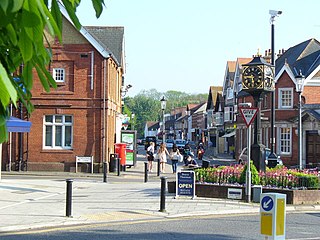
Cobham is a large village in the Borough of Elmbridge in Surrey, England, centred 17 miles (27 km) south-west of London and 10 miles (16 km) northeast of Guildford on the River Mole. It has a commercial/services High Street, a significant number of primary and private schools and the Painshill landscape park.

Weybridge is a town in the Borough of Elmbridge in Surrey, England, around 17 mi (27 km) southwest of central London. The settlement is recorded as Waigebrugge and Weibrugge in the 7th century and the name derives from a crossing point of the River Wey, which flows into the River Thames to the north of the town centre. The earliest evidence of human activity is from the Bronze Age. During the Anglo-Saxon and medieval periods, Weybridge was held by Chertsey Abbey.
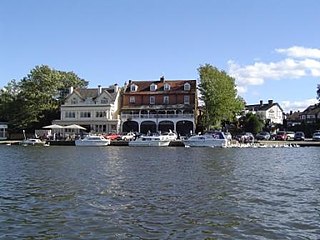
Elmbridge is a local government district with borough status in Surrey, England. Its council is based in Esher, and other notable towns and villages include Cobham, Walton-on-Thames, Weybridge and Molesey. The borough lies just outside the administrative boundary of Greater London, but is mostly within the M25 motorway which encircles London. Many of the borough's urban areas form part of the wider Greater London Built-up Area.

Chertsey is a town in the Borough of Runnymede, Surrey, England, 18 miles (29 km) south-west of central London. It grew up around Chertsey Abbey, founded in AD 666 by St Erkenwald, and gained a market charter from Henry I. A bridge across the River Thames first appeared in the early 15th century. The River Bourne through the town meets the Thames at Weybridge. The Anglican church has a medieval tower and chancel roof. The 18th-century listed buildings include the current stone Chertsey Bridge and Botleys Mansion. A curfew bell, rung at 8 pm on weekdays from Michaelmas to Lady Day ties with the romantic local legend of Blanche Heriot, marked by a statue of her and the bell at Chertsey Bridge. Green areas include the Thames Path National Trail, Chertsey Meads and a round knoll with remains of a prehistoric hill fort known as Eldebury Hill. Pyrcroft House dates from the 18th century and Tara from the late 20th. Train services are run between Chertsey railway station and London Waterloo by South Western Railway. The town is within the M25, accessible via junction 11.

Runnymede and Weybridge is a constituency in Surrey represented in the House of Commons of the UK Parliament since 2019 by Ben Spencer, a Conservative.
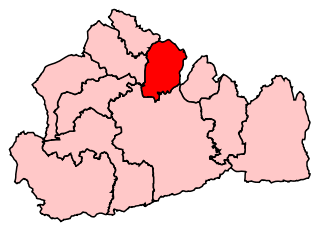
Esher and Walton is a constituency in Surrey represented in the House of Commons of the UK Parliament. Since 2010, it has been represented by Dominic Raab of the Conservative Party, who served as deputy prime minister before resigning from that role in April 2023 due to bullying allegations. In May he announced he would be standing down as an MP at the next general election.

Addlestone is a town in Surrey, England. It is located approximately 18+1⁄2 miles southwest of London. The town is the administrative centre of the Borough of Runnymede, of which it is the largest settlement.

Painshill, near Cobham, Surrey, England, is one of the finest remaining examples of an 18th-century English landscape park. It was designed and created between 1738 and 1773 by Charles Hamilton. The original house built in the park by Hamilton has since been demolished.
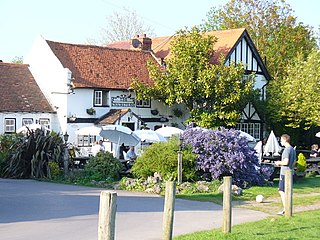
Downside is a small village in the English county of Surrey, in the local government district of Elmbridge, centred on Downside Common which is 18 miles (29 km) southwest of London and 8.4 miles (13.5 km) northeast of Guildford. Most of its buildings form a cluster. It has an inn, Downside Sports and Social Club, regular village hall events and an annual sports day. It is in the Cobham and Downside ward of Elmbridge Borough Council.
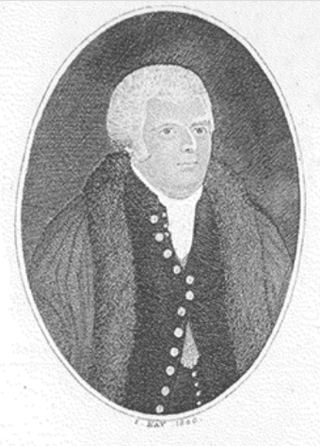
Harvey Christian Combe was an English Whig politician. He was the eldest surviving son of Harvey Combe, attorney, of Andover, Hampshire. He served as Lord Mayor of London 1799/1800.

Lawrence James Baker was an English stockbroker and a Liberal politician who sat in the House of Commons from 1885 to 1886.
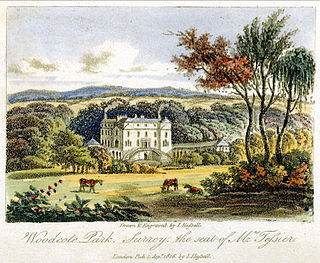
Woodcote Park is a Grade II* listed stately home and estate of about 350 acres near Epsom, Surrey, England, currently owned by the Royal Automobile Club. It was formerly the seat of a number of prominent English families, including the Calvert family, Barons Baltimore and Lords Proprietor of the colony of Maryland. The interior of the house once boasted a gilded library and number of fine murals by notable Italian artists including Antonio Verrio, but most of the historic rooms were removed by the RAC, which had purchased the estate in 1913, and what remained was destroyed by fire in 1934. The present appearance of the house dates from its restoration in 1936. However, the interior of one of the original drawing rooms still survives in the Museum of Fine Arts at Boston, Massachusetts. The estate was used by the military as a convalescent hospital in the First World War and as a training camp in both world wars.
George Lane, 1st Viscount Lanesborough was an Irish politician.
Country house conversion to apartments is the process whereby a large country house, which was originally built to accommodate one wealthy family, is subdivided into separate apartments to allow multiple residential occupancy by a number of unrelated families. They are usually, by virtue of their age or style, listed buildings. The re-purposing of these mansions is one alternative to their demolition; there was wide-spread destruction of country houses in 20th-century Britain, but remodelling them as multiple dwelling units became a more popular option after the Destruction of the Country House exhibition in 1974.
Nicholas Lane was an English surveyor and cartographer, active in the early part of the seventeenth century, rising to prominence in his works for King Charles I.

Hatchford is a hamlet in the English county of Surrey outside the town of Cobham ; it traditionally includes the contiguous hamlet of Pointers Green.

Botleys Mansion is a Palladian mansion house in the south of Chertsey, Surrey, England, just south of St Peter's Hospital. The house was built in the 1760s by builders funded by Joseph Mawbey and to designs by Kenton Couse. The elevated site once bore a 14th-century manor house seized along with all the other manors of Chertsey from Chertsey Abbey, a very rich abbey, under Henry VIII's Dissolution of the Monasteries and today much of its land is owned by two hospitals, one public, one private and the local council authority. The remaining mansion and the near park surrounding were used for some decades as a colony hospital and as a private care home. The building is owned and used by a wedding venues company.

Silvermere is an estate in Surrey, England named after its mere – a shallow lake of about ten acres which has a silvery appearance when seen from the surrounding slopes. It was created in the 19th century for the rich architect, William Atkinson, and subsequently became the home of the Seth Smith family, who had also become wealthy from property development. An ancient British burial mound was found on the land and the Silvermere Urn was found within. During World War II, the mere was used for experiments to develop and test the bouncing bomb. The estate is now a golf course and the final green is on an island in the mere.
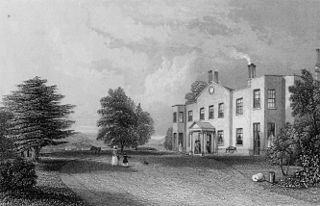
Denbies is a large estate to the northwest of Dorking in Surrey, England. A farmhouse and surrounding land originally owned by John Denby was purchased in 1734 by Jonathan Tyers, the proprietor of Vauxhall Gardens in London, and converted into a weekend retreat. The house he built appears to have been of little architectural significance, but the Gothic garden he developed in the grounds on the theme of death achieved some notoriety, despite being short-lived. The estate was bought by Lord King of Ockham following Tyers's death in 1767, and the macabre artefacts he had installed, including two stone coffins topped by human skulls, were removed.
John Machell (1637–1704) was for twenty years Member of Parliament for Horsham, Sussex, during the reigns of Charles II, James II and William III and Mary II. By the marriage of his daughter Isabella Machell (1670–1764) to Arthur Ingram, 3rd Viscount of Irvine, he became the grandfather of the fourth, fifth, sixth, seventh and eighth Viscounts of Irvine, and great-grandfather of the ninth, seated at Temple Newsam near Leeds, whose family inherited and augmented his valuable property of Hills house at Horsham, and continued the parliamentary tradition there.

















